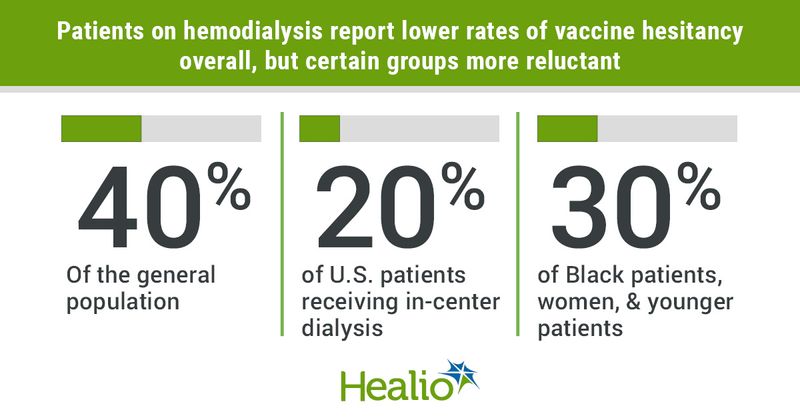US patients on hemodialysis show varying degrees of COVID-19 vaccine hesitancy
Approximately 20% of patients receiving in-center hemodialysis in the United States expressed hesitancy toward COVID-19 vaccination, according to a joint survey conducted by Stanford University School of Medicine and U.S. Renal Care.
This, according to researchers, is approximately half the rate of vaccine hesitancy of the general U.S. population (a 40% hesitancy rate) and could partially be explained by greater interactions with the medical community (instilling patient-provider trust) or a recognition of increased vulnerability.

However, results of the nationwide survey also revealed vaccine acceptability varied by race, sex and age group, with Black patients, women and younger patients demonstrating more reluctance.
“Considering the serious health implications of SARS-CoV-2 infection in patients receiving dialysis, combined with the potential for increased risk for exposure with travel to, from and during the provision of in-center hemodialysis or cross-traffic between dialysis facilities and skilled nursing facilities, some states are prioritizing vaccination to these patients, almost half of whom are also over 65 years of age,” Pablo Garcia, MD, and colleagues wrote. “A substantial fraction of persons receiving dialysis, however, belong to racial, ethnic, socioeconomic, cultural and religious groups more likely to be vaccine hesitant. In order to inform programs and policies aimed at promoting COVID-19 vaccine uptake in this vulnerable population, we offered a nationwide survey to persons undergoing in-center hemodialysis in 150 randomly selected facilities in January 2021.”
A total of 10,974 patients responded to the survey, which was available in both English and Spanish (13% reported having a family member or close acquaintance who died from COVID-19). According to the researchers, respondents were representative of the dialysis population in the United States based on age, sex and race/ethnicity (25% were Hispanic, 30% were Black and 56% did not have a college degree), though there was underrepresentation of individuals in the Midwest (and no responses from the Northwest).
Findings showed that, regardless of whether the vaccine was deemed safe for the general population, 20% of total respondents expressed hesitancy toward vaccination. For comparison, the researchers highlighted that 13% did not, or were not planning, to receive an influenza vaccine during the 2020 to 2021 season (patients who were planning to, or who had received, the flu vaccine were less likely to be hesitant of the COVID-19 vaccine).
Vaccine acceptability differed by subgroup, with almost 30% of women, Black patients, patients described in the research as “Native Americans and Pacific Islanders” and younger patients (aged 18 to 44 years) expressing reluctance.
“Outreach efforts need to be targeted to these groups,” co-investigator Shuchi Anand, MD, said in a related press release. “Racial and ethnic minority groups represent a substantial portion of persons on dialysis. Also, younger age groups, while less susceptible to serious illness, will come in close contact with older people since they will go to shared facilities multiple times per week for dialysis, so outreach and high vaccine acceptability is crucial for this age group as well.”
Findings related to specific reasoning for vaccine hesitancy showed that, overall, patients were concerned with adverse events, doubted efficacy or were uncomfortable with vaccines in general.
Despite lingering hesitancy for some patients, Anand viewed the results in a positive light.
“Finding that 80% of patients on dialysis were willing to get a COVID-19 vaccine is a fantastic sign for potentially reaching high rates of vaccination in our population,” she said. “This high level of acceptance may be due to the routine provision of vaccines at dialysis facilities, many of which have worked hard to increase influenza vaccination and hepatitis B vaccination coverage in this vulnerable population over the past decade.”

